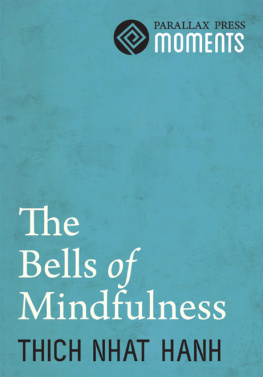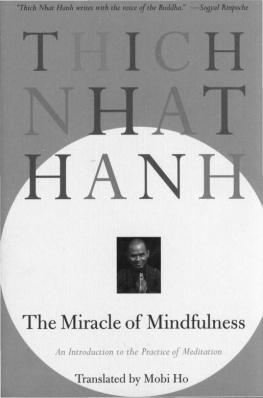I WANT TO THANK all the teachers who have guided me and helped me to walk the path of understanding, love, and freedom. First, Id like to thank my mother, who prayed with me every night when I was a child, and the kind Pastor Rcker in our Swabian village, who was in charge of my confirmation.
The two teachers Im most devoted to are German-American Vipassana teacher Ruth Denison and Vietnamese Zen master Thich Nhat Hanh. Im deeply grateful to both of them for their invaluable teachings. I also want to thank the entire Sangha of Plum VillageThich Nhat Hanhs monastery and retreat center near Bordeaux, Franceand all the nuns, monks, and laypeople there and at the European Institute of Applied Buddhism in Waldbrl near Cologne, Germany.
Many thanks to all my friends in our Source of Compassion Sangha (Quelle des Mitgefhls) in Berlin and our small home Sangha at the Little Dharma Castle (Dharma Schlsschen).
A big thanks to my editor of the original German edition, Ursula Richard, who was a caring and wise guide during the time I was working on this book. I couldnt have done it without her. I also want to thank my good friend, Janina Egert, who has always supported me in many different ways.
ANNABELLE ZINSER was born in 1948 in Swabia (Baden-Wuerttemberg, Germany). After she received her masters degree in history and political science, she worked as a social worker in Berlin. She trained as a massage therapist and yoga teacher and worked in both fields for many years.
In 1982, she attended her first meditation class with Sylvia Wetzel. While traveling in India in 1988, she participated in a Vipassana meditation retreat under the guidance of S.N. Goenka. Shortly afterwards, she met the German-American Vipassana teacher Ruth Denison at the Waldhaus am Laacher See near Koblenz, Germany. Annabelle studied with Ruth Denison for many years. She also received permission to teach the Dharma from Ruth Denison.
In 1992, she met Thich Nhat Hanh for the first time at the European Buddhist Congress in Berlin. Since 2000, she has spent time at his monastery, Plum Village, near Bordeaux, France, on a regular basis. Annabelle entered the Order of Interbeing in 2003 and received the Lamp Transmission from Thich Nhat Hanh in 2004 to become a Dharma teacher, which authorized Annabelle to teach in his tradition.
Annabelle became a member of the Buddhist Academy Berlin-Brandenburg in 2001. In 2002, she began to build the Source of Compassion (Quelle des Mitgefhls), a Buddhist meditation center in the tradition of Plum Village in Berlin, Germany. She currently leads the Quelle des Mitgefhls meditation center.
RELATED TITLES FROM PARALLAX PRESS
Awakening Joy: 10 Steps to Happiness
James Baraz and Shoshana Alexander
Chanting from the Heart:
Buddhist Ceremonies and Daily Practices
Thich Nhat Hanh and the Monks and Nuns of Plum Village
Happiness: Essential Mindfulness Practices
Thich Nhat Hanh
Loves Garden: A Guide to Mindful Relationships
Peggy Rowe Ward and Larry Ward
Making Space: Creating a Home Meditation Practice
Thich Nhat Hanh
Present Moment Wonderful Moment:
Mindfulness Verses for Daily Living
Thich Nhat Hanh
Ten Breaths to Happiness:
Touching Life in Its Fullness
Glen Schneider

Parallax Press, a nonprofit organization, publishes books on engaged Buddhism and the practice of mindfulness by Thich Nhat Hanh and other authors. All of Thich Nhat Hanhs work is available at our online store and in our free catalog. For a copy of the catalog, please contact
Parallax Press
P.O. Box 7355
Berkeley, CA 94707
Tel: (510) 525-0101
www.parallax.org
W HEN PRACTICING sitting meditation, its important to have a supportive cushion. Sitting should be comfortable, not painful. If a cushion isnt comfortable or supportive enough, you can use a meditation bench or a chair. If you sit on a cushion, you can put one foot on the opposite thigh, both feet on the opposite thighs, or simply sit cross-legged. When sitting on a cushion, your knees should touch the floor; if they dont, you can support each knee with a small cushion. If you choose to sit on a chair, try not lean back in the chair. Sit with your spine straight, your knees relaxed, and your feet flat on the floor or on a cushion.
Always sit with a relaxed and straight spine. This will make your posture stable. Be sure your position is comfortable and relaxed. You may want to slightly lower your chin to avoid creating tension in your neck. You can rest your hands on your thighs with palms up or down, or else one on top of the other in your lap with palms facing up. Other options are to interlock your fingers in a prayer position or to use a basic mudra, hand gesture, in which the thumbs and index fingers, or thumbs and middle fingers, touch. The most important thing is to find a comfortable and relaxed position.
As you maintain awareness of breathing in and out, let your breath flow naturally without trying to influence it. Your breath may be long or short, shallow or deep. Simply notice it and observe it. Become aware of your abdomen expanding as you inhale and contracting as you exhale. Become aware of the contact of your legs or your feet touching the floor. Feel the floor and the cushion or chair supporting you. Be aware of your shoulders and arms and the position of your hands, and allow them to relax.
If your mind starts to wander, you can gently acknowledge this by naming it: This is daydreaming, or, This is thinking. Then return to your breathing. Rejoice in every conscious in-breath and out-breath. Dont fight with your mind. Meditation doesnt mean that you turn yourself into a battlefield. Just enjoy the degree of concentration thats possible in this very moment.
To help develop concentration, some people like to count their breaths from one to ten. You can make an in-breath number one and an out-breath number two. Or you can make one in- and out-breath number one and the next number two. Just count in whatever way is most natural for you. You can count to ten this way and then start over again. Or you may silently say in as you breathe in and out as you breathe out. Once in a while, you might acknowledge the noises around you and focus your mind by simply listening. Counting or naming are tools that help keep the mind focused on your breathing. You also want to become aware of the feelings that arise as you breathe in and out. If you feel pain in your knees or back, you can adjust your sitting position slowly and quietly in order to not disturb others. But before changing position its helpful to explore the painful area and see how the pain changes as you inhale and exhale. (See Opening Up to Physical Pain, p. 96)
At the beginning or end of the meditation, you can repeat one phrase or several loving kindness phrases directed toward yourself or toward others. You may say:
May I be peaceful, happy, and at ease in body and mind.
You can also dedicate your meditation to someone close to you, or to another person or group of people who are suffering. You can send them your wishes for their well-being:
May you be peaceful, happy, and at ease in body and mind.
May your pain give rise to greater compassion for yourself and others.
When you adopt a meditation practice its important to begin with the amount of time that suits your needs and schedule. You may start by sitting for five or ten minutes and then gradually sit for longer periods as you get more comfortable with the practice. You may eventually extend the time to twenty, thirty, or forty-five minutes. If you start out by sitting for too long, you might drop your practice after a few weeks because its too big a commitment. That would be a pity, because then you would lose contact with this wonderful, ancient practice thats brought healing to so many people. However, it is important that you practice sitting meditation on a daily basis in order to develop a certain rhythm and skill in your practice. This is the only way youll be able to harvest the fruits of your practice: greater openness, serenity, joy, peace, mindfulness, concentration, deep understanding, and insight.






